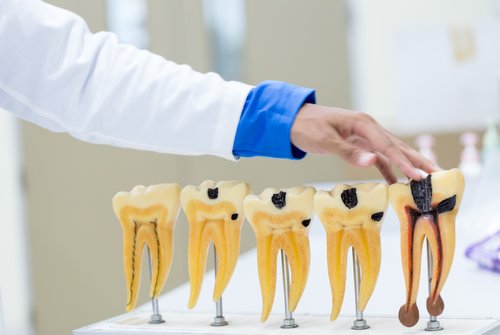ROOT CANAL TREATMENT
Cleansing, Reshaping, Filling
Root Canal Treatment
Deeply decayed or infected teeth necessitate Root Canal Treatment (RCT) to halt the spread of infection. RCT is a meticulous three-step procedure that involves cleansing, reshaping, and filling the root canals. Typically, a crown is recommended post-treatment to preserve the remaining tooth structure, ensuring both functionality and structural integrity. Don’t delay – seek timely treatment to safeguard your valuable dental health and maintain a healthy smile.
Assesment
Assessing a tooth for root canal treatment involves evaluating clinical symptoms, radiographic findings, and vitality tests to determine the extent of infection or damage to the pulp. This guides the decision for the necessity and complexity of the root canal procedure.
Cleansing
Local anesthesia is administered to numb the tooth. After applying rubber dam an opening is made in the tooth to access the pulp chamber and root canals. The infected nerve is removed from the tooth’s interior with help of files and irrigation . The tooth is dressed up temporarily.
Reshaping
The root canals are cleaned, enlarged, and shaped using rotary files to remove bacteria, debris, and any remaining pulp tissue. Antibiotic paste is placed in the canals to deal with any residual infection.
Filling
Once the root canals are thoroughly cleaned and shaped, they are filled with a rubber-like material to seal them and prevent further infection.
Restoring
After the root canal treatment is completed, the tooth is restored with a crown to strengthen and protect it. In some cases, a post may be placed inside the tooth to provide additional support for the crown.
Home Care Tips
Avoid Chewing on the Treated Tooth, Practice Good Oral Hygiene, Use Antiseptic Mouthwash, Avoid Hard and Sticky Foods
Frequently Asked Questions
What Are the Risks and Complications?
Root canal treatment (RCT) is generally safe but carries risks such as incomplete removal of infected tissue, which may lead to persistent infection or abscess formation. There’s a possibility of instrument fracture within the root canal, necessitating additional procedures or surgery to retrieve the fragment. Overfilling or underfilling of the root canal can cause irritation or damage to surrounding tissues, potentially leading to inflammation or discomfort. Rare complications may include damage to adjacent structures like nerves or sinus perforation, requiring further intervention to address. Thorough planning and careful instrumentation will mitigate these risks.
How Successful Is the Treatment Likely to Be?
The success rate of root canal treatment (RCT) is high, with studies showing success rates of around 85-95% over several years. However, success depends on various factors including the presenting condition of tooth , severity of infection, the quality of the initial treatment, and the patient’s oral hygiene habits post-treatment. Regular follow-up visits and maintaining good oral hygiene practices can significantly contribute to the long-term success of RCT.
What Can I Expect During Recovery?
Are there any foods or activities I should avoid?
After a root canal treatment (RCT), it is important to take certain precautions:
1. Avoid Hard and Chewy Foods:Refrain from eating hard, chewy, or sticky foods that could damage the temporary filling or the treated tooth. Stick to soft foods until your permanent crown is placed.
2. Limit Hot and Cold Foods:Your tooth might be sensitive to extreme temperatures, so avoid very hot or cold foods and drinks.
3. Chew on the Opposite Side: Chew on the side of your mouth opposite the treated tooth to avoid putting pressure on it until it is fully restored with a crown.
4. Maintain Good Oral Hygiene: Continue brushing and flossing regularly, but be gentle around the treated area to avoid irritation.
5.Get a Crown within Two Months: Schedule a follow-up appointment to place a permanent crown on the treated tooth within two months to prevent it from cracking or breaking, as a tooth that has undergone RCT can become brittle.Following these guidelines will help ensure a smooth recovery and long-term success of your root canal treatment.

